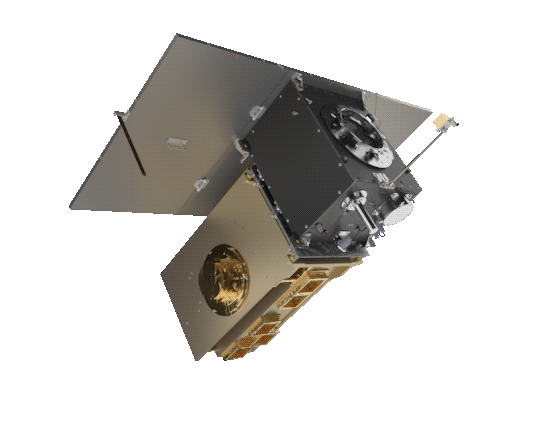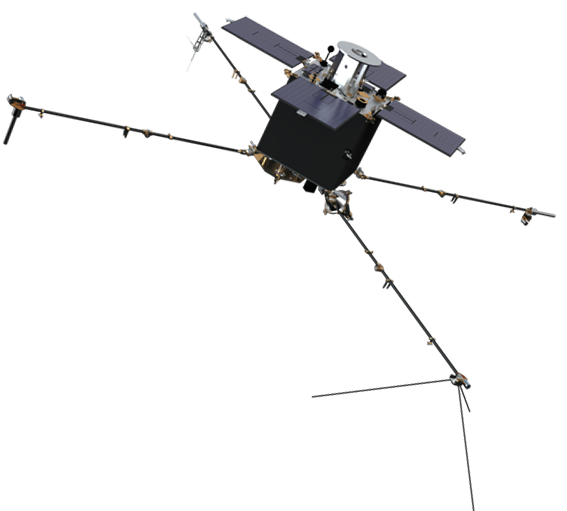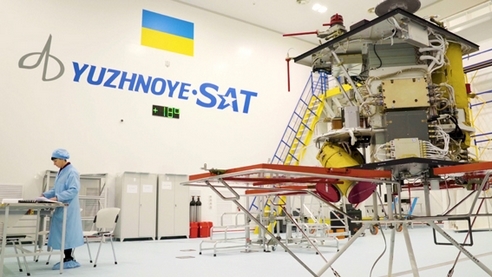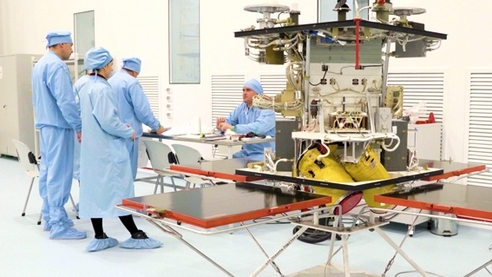Scientific spacecraft
HomeScientific spacecraft HomeScientific spacecraft
YuzhSat-1
EARTH REMOTE SENSING SPACECRAFT
DESCRIPTION
The YuzhSat-1 microsatellite with payload for the Aerosol-UA scientific experiment is intended for global monitoring of physical characteristics, spatial and temporal distribution of aerosols in the Earth atmosphere, drastically improving consideration of their contribution to energy budget in climate models.
The microsatellite payload measures intensity and polarization of reflected/scattered solar radiation in visible and IR bands at a low Earth orbit.
SATELLITE BASIC SPECIFICATIONS
| Mass, kg: | 38.4 |
| Orbit: | |
| – type | circular sun-synchronous |
| – altitude, km | ~705 |
| – inclination, deg | ~98.1 |
| Orientation: | |
| – type | 3-axis active |
| – actuating devices | magnetorquers, reaction wheels |
| Payload supply power, W: | |
| – maximum | 80 |
| – daily average | 20 |
| Tilting range, deg | ±35 |
| Orientation accuracy, deg | 0.2 |
| Stabilization accuracy, deg/s | 0.01 |
| Orientation determination accuracy, deg | 0.1 |
| Design life, years | 2 |
PAYLOAD BASIC SPECIFICATIONS
Aerosol-UA Scientific Equipment Complex
Scanning photometer-polarimeter (ScanPol)
| Operating wavelength, cm | ~3.1 (X-band) |
| Scanning along ground track from nadir, deg | +50/-60 |
| Photometric accuracy, % | 5 (10% for 1378 nm and 1610 nm) |
| Polarimetric accuracy, % | 0.2 |
| Polarimetric stability, %/year | 0.2 |
| I, U, Q Stokes parameters in 6 spectral bands at a time | |
| Spectral bands, nm | 370, 410, 555, 865, 1380, 1610 |
| Spectral channel transmission windows, nm | 20 (60 for 1380 and 1610) |
| Signal/noise | ~2000 for albedo 0.1 and solar zenith angle 60 deg (400 for 370 nm channel) |
| Field of view along flight path, deg | 0.5 |
| Nadir resolution, km | ~6 |
MULTISPECTRAL IMAGER-POLARIMETER (MSIP)
| Spectral bands, nm | 410, 555, 865, 1380 |
| Spectral channel transmission windows, nm | 40 (60 for 1380) |
| Signal/noise | 100 for albedo 0.1 and solar zenith angle 60 deg |
| Pixel size at the surface | 500 m |
| Imaging along ground track with spatial resolution in nadir, km | ~3 |
| Visual field size, deg | 60х60 |
Microsat-M
EARTH REMOTE SENSING SPACECRAFT
DESCRIPTION
The MicroSat-M spacecraft is designed for dynamic processes observation in the earth’s ionosphere, as well as technological experiments in the space environment.
The spacecraft payload incorporates the Ionosat-Micro scientific equipment complex for ionospheric research; some sensors of the Ionosat-Micro are installed on deployable booms of more than 2 meters in length.
The MicroSat-M is developed based on the MS-2 bus that was used for the Sich-2 satellite launched in 2011.
SATELLITE BASIC SPECIFICATIONS
| Mass, kg: | |
| – satellite | 195 |
| – payload | 75 |
| Orbit: | |
| – type | circular sun-synchronous |
| – altitude , km | ~668 |
| – inclination, deg | ~98.1 |
| Attitude control: | |
| – type | 3-axis active |
| – sensor | 3-axis magnetometer |
| – actuators | magnetorquers,
reaction wheel |
| Orientation accuracy, deg, no worse than | 5 |
| Design life, years | 3 |
PAYLOAD BASIC SPECIFICATIONS
Ionosat-Micro Scientific Equipment Complex
| Wave complex MWC: | |
| – wave probes WP1, WP2, WP3 | Measurement of electric current density, magnetic field and electrical potential within frequency range 0.1 Hz — 40 kHz |
| – electric probe ЕР | Measurement of electrical potential within frequency range DC — 200 kHz |
| – fluxgate magnetometer FGM | Measurement of magnetic field vector within frequency range DC — 1 Hz ,
Dynamic range ±65000 nT,
Resolution 0.01 nT |
| Particle density analyzer (PDA): | |
| – plasma neutral component sensor DN | Measurement of neutral particle concentration 105…1011 cm-3, neutral particle temperature 600…2000 К |
| – plasma electronic component sensors DE | Measurement of charged particle concentration 103 — 108 cm-3, electron temperature 0.1 —1.0 eV
Ion temperature 700 — 2500 К |
| – PDA electronics module | Measurement of currents in sensors DN-DE 10-10 — 10-4 А and their temperature |
| Radio frequency analyzer RFA | Measurement of electric field spectrum within frequency range 20 kHz — 15 MHz |
| Ionic driftmeter ID-2 | |
| Scientific data collection system SDCS | Mass memory capacity is 100 Gbytes |
Small astromeasuring system SAMS-B
| Orientation accuracy relative to inertial coordinate system, arcsec: | |
| – optical axis | 6 |
| – about optical axis | 45 |
| Information updating period, s | 0.1 |
Gimballess stellar inertial unit GSIU-02
| Angular velocity vector projections measurement range, deg/s | ±10 |
| Angular velocity vector projections accuracy, deg/h | 0.14 |
| Maximum orientation quaternion drift rate (without correction based on SAMS-B measurements), deg/h | 0.24 |
X-band high-speed radio link equipment
| Data transmission rate, Mbit/s | 320 |
| Modulation type | OQPSK |
Ammonia propulsion system
| Thrust, N | 0.049 |
| Specific impulse, m/s: | |
| – “hot” mode | 2500 |
| – “cold” mode | 882 |
Experimental solar arrays
| Cell type: | |
| – module 1-1 | Single junction GaAs/Ge |
| – modules 1-2 and 2-1 | Three-junction InGaP/GaAs/Ge |
| – module 2-2 | Three-junction InGaP/GaAs/Ge |
| Efficiency (for AM0 conditions), %: | |
| – module 1-1 | 21.5 |
| – modules 1-2 and 2-1 | 25 |
| – module 2-2 | 27.5 |
| Specific power, W/m2: | |
| – module 1-1 | 263 |
| – modules 1-2 and 2-1 | 340 |
| – module 2-2 | 374 |
Experimental battery
| Battery type | Li-ion |
| Nominal capacity, A×h | 3 |
Panels with thermal control coatings
| Type of thermal control coating: | |
| – white | Polyurethane PU-1 |
| – black | Epoxy-polyurethane EU-1 |






